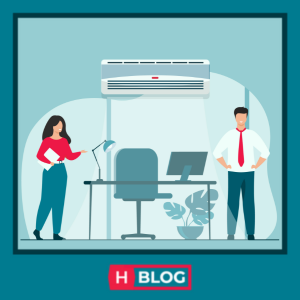
Summer is on us, which means air-conditioning is being turned on in most offices and other places of business. Since the temperature of the work environment affects the health as well as the productivity of the work force, it is regulated by law to ensure the well-being of your employees.
Before diving into the details, the relevant law specifies that the work place temperature must be appropriate to the type of work and the physical exertion that goes with it. The acceptable temperature in each case is as follows:
| intellectual / sedentary work | 21-24°C |
| light physical work | 19-21°C |
| medium difficulty physical work | 17-19°C |
| heavy physical work | 15-17°C |
(If you want to learn more about expected workplace temperature in winter, click here.)
While these categories of work difficulty are defined very scientifically, by the energy output expressed in kJ/hour, practically they refer to how much time you must spend sitting or standing up, walking around, and lifting objects (also considering how heavy these objects may be, and whether you need protective clothing). At an office, most work is sedentary.
Temperature is supposed to be measured regularly. In case of sedentary jobs, the thermometer is supposed to be placed at 0.5m from the ground; in case of physical work, at 1m from the ground.
The law does not expressly specify humidity, but it also affects apparent temperature, and experts suggest it should be somewhere between 40-55% for office jobs. Keep in mind that air-conditioning dries the air; however, in summer that rarely becomes a problem if the weather is otherwise humid, and the office is aired every day (preferably in the early morning or the evening hours).
These days most offices have their own air-conditioning. To prevent health hazards and maintain the productivity of your employees, make sure to set the AC to a temperature that is appropriate for their work.
Some food for thought:
In addition, consider the dress code at the office. In formal settings, men are often required to wear warmer clothes (suit with the jacket on), while women have more freedom to dress for the summer. This can increase the difference of temperature needs between male and female employees and might lead to animosity among your team. In such cases, introducing a more lenient dress code for men while encouraging female colleagues with a colder disposition to dress keeping the AC in mind can help achieve a compromise.
In any case, inviting an open discussion of the topic of air-conditioning at the office can help employees take a more active role in creating a work environment that is beneficial to every member of the team.
In case the office temperature goes above 24°C (e.g. if the air-conditioner breaks down), the employer must adopt measures to mitigate the health risks of their employees:
The highest temperature allowed at the office is 31°C.
The goal of regulations is to make sure that your employees can remain healthy and productive. While you will probably not be able to set a temperature for the air-conditioner that is just right for everyone, discussing the topic openly and finding a compromise can contribute not only to compliance with the relevant law but also to a warmer atmosphere at the office.
Helpers Hungary was started in 2005, and since then our team has provided expert assistance and consultancy to expats living, working, and doing business in Hungary. If you need any help with administration and compliance, feel free to contact us.
Was this article useful? Follow us on Facebook and never miss an update.
КОНТАКТ

If you are looking for a home in Hungary, make sure to ask the seller or the landlord for the energy performance certificate to get a better idea of what living in your new home will be like, and how much you should expect to pay for utilities.
Далее
According to a new proposal, digital companies where more than 60% of the employees are third-country nationals could enjoy significant tax benefits.
Далее